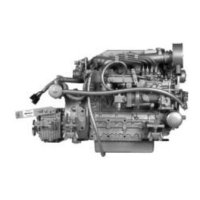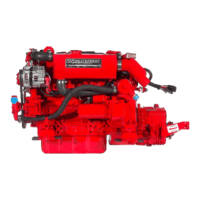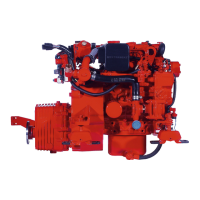DC
ELECTRICAL
SYSTEM
ENGINE
12
VOLT
DC
CONTROL
CIRCUIT
The engine has a
12
volt DC electrical control circuit that
is
shown on the wiring diagrams that follow. Refer
to
these dia-
grams when troubleshooting or when servicing the DC elec-
trical system on the engine.
DRIVE
BELT
ADJUSTMENT
A
CAUTION:
Drive
belts
must
be
properly
tensioned.
Looss
drille
belts
will
not
provide
proper
alternator
charging
and
will
eventually
damage
the
alternator.
DrllIB
belts
that
are
too
tight
will
pull
the
alternator
out
of
alignment
and/or
cause
the
alternator
to
wear
out
pre-
maturely.
Belt tension adjustment is made by pivoting the alternator on
· its base mounting bolt.
1.
Loosen the alternator adjusting strap bolt and the base
mounting bolt.
2.
Pivot the alternator on the base mounting bolt
to
the left
or
right
as
required.
3. Tighten the base mounting bolt and the adjusting strap
bolt.
4. Operate the engine for about 5 minutes at idle, then shut
down and recheck belt tension.
/'<-
~
BATTERY
CARE
Review
the
manufacturer's
recommendations
and
then
establish a systematic
maintenance
schedule
for
your
engine
starting
batteries
and
house
batteries.
• Monitor your voltmeter for proper charging during engine
operation.
• Check
the
electrolyte level and specific gravity with a
hydrometer.
• Use only distilled water
to
bring electrolytes
to
a proper
level.
• Make certain that battery cable connections are clean and
tight to
the
battery posts (and to your engine).
•
Keep
your
batteries
clean
and
free
of
corrosion.
21
GLOW
PLUGS
The glow plugs are wired through the preheat solenoid.
When
PREHEAT
is
pressed at the control panel this solenoid
should
"click" on and the glow plug should begin
to
get hot.
Inspection
To
inspect the plug, remove the electrical terminal connec-
tions, then unscrew or unclarnp each plug from the cylinder
head. Thoroughly clean each plug's tip and threads with a
soft brush and cleaning solution
to
remove
all
the carbon and
oil
deposits. While cleaning, examine the tip for wear and
burn erosion; if
it
has eroded too much, replace the plug.
Testing
An accurate way to test glow plugs
is
with an ohmmeter.
Touch one prod
to
the glow plug's wire connection, and the
other to the body
of
the glow plug,
as
shown. A good glow
plug will have a
0.7 - 0.8 ohm resistance. This method can be
used with the plug in or out
of
the engine.
You
can also use
an
ammeter to test the power drain
(8
- 9 amps per plug).
.
A
WARNING:
These
glow
plugs
will
become
very
hot
to
the
touch.
Be
careful
not
to
bum
your
fingers
when
testing
the
plugs.
Re-install the plugs in the engine and test them again. The
plugs should get very hot (at the terminal end) within 7
to
15
seconds.
If
the plugs don't heat up quickly, check for a short
circuit. When reinstalling the glow plugs, use anti-seize
compound
on
the
threads.
A
WARNING:
00
not
keep
a
glow
plug
on
for
more
than
30
seconds.
GLOW
PLUG
TIGHTENING
TORQUE:
7 ·11
Ft·lb
(1.0·
1.5
m·kg)
TERMINAL
END
TIP
TESTING
A
GLOW
PLUG
WITH
AN
OHMMETER

